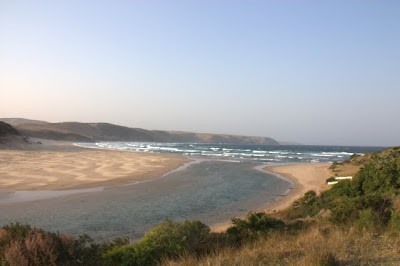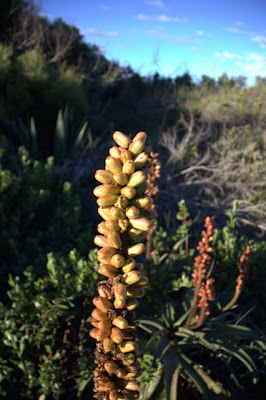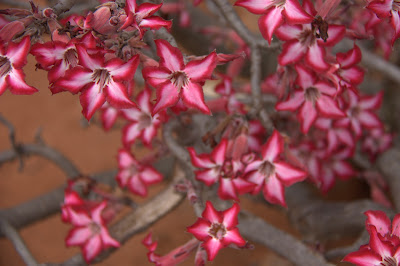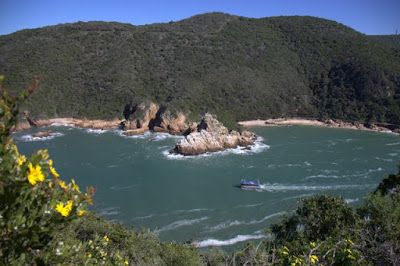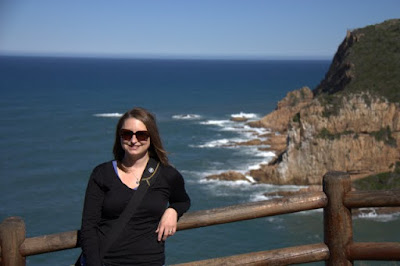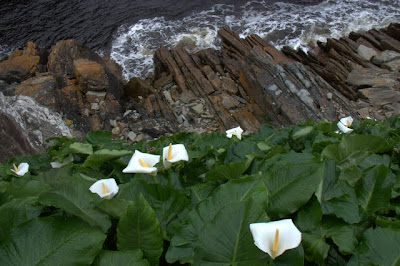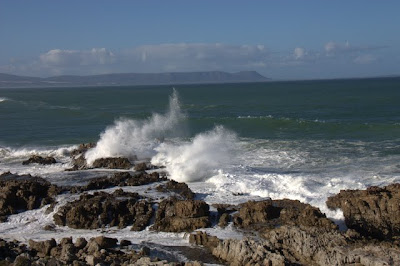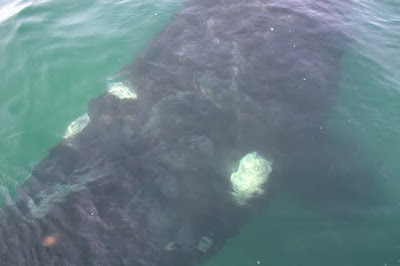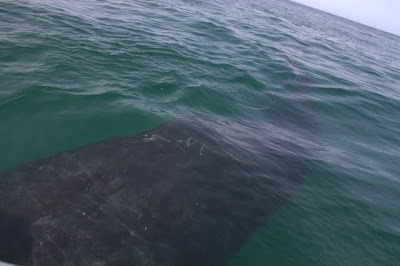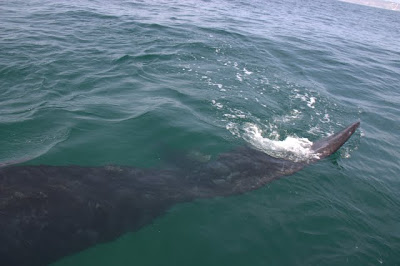Bulungula, Part One
There’s a place on the Wild Coast of South Africa that I am sure will stack up to be one of the most memorable and most unique places we stayed on this trip. The place is Bulungula Lodge, an eco-friendly and fair trade lodge totally off the grid located in a remote area of South Africa. The Lodge is the type of place that can restore a little bit of my liberal, tree-hugging, idealistic heart that practicing law killed off with cynicism.
The Lodge was created by Dave Martin, a well-traveled man originally from Cape Town who wanted to put his ideals into action. Created in 2004, the Lodge is a partnership between Martin and the local Nqileni village, made up of Xhosa people. The village owns the riverfront/oceanfront land occupied by the Lodge, and 40% of the Lodge itself. That means locks aren’t needed on the doors of the huts for the guests and people won’t hassle you for money, because everyone has a vested interest in the business. The village selects the neediest people to work at the Lodge, such a widow who needs the income. In addition to the creation of jobs at the Lodge itself, the Lodge spawned a number of 100% community-owned and operated businesses. Guests have the opportunity to engage in horseriding, canoeing, or fishing with a guide; eat at a pancake restaurant in the village; get a massage; go on a tour of the village; spend time and work with the village women; or learn about herbs from the herbsman. Other than the Lodge, there is no other place for employment anywhere in sight. Many of the village men live in townships in Johannesburg most of the year, working in the mines and sending meager incomes back home.
The journey to get to Bulungula Lodge is part of the experience in of itself. The lodge is located somewhere somewhat near Coffee Bay on the Wild Coast of South Africa, an area with relatively unspoiled coastline and some of South Africa’s poorest people. Once you turn off of N2, the main highway – which already is not all that developed for miles – any sign of commercial life disappears, save for a gas station, one Spar grocery store, and later, a local general store or two scattered about. The first road wasn’t too bad, that is, until it started to resemble the moon. We spent a good half an hour swerving to the left and right, trying, unsuccessfully, to avoid the giant craters in the road. Once we turned off the crater road, it was dirt roads the rest of the way. The “roads” were in such bad condition, it wasn’t possible to drive faster than, say, 10 miles per hour. The drive made me fully understand the meaning of bone-jarring. Every bone in our bodies rattled and jangled as we bounced along in our little rental car for close to 3 hours(!) at a ploddingly slow pace, praying we wouldn’t get a flat tire or a giant gash in our gas tank. To top it off, I had the need to pee well before we turned off the N-2, which made each bounce extra fun.
Two white people in a tiny, decidedly non-4×4 rental car inevitably attracted much attention. Small children began to run out to the road, waving frantically at us and jumping up and down. Older children tried to look indifferent or intimidating, but inevitably one of them would sheepishly wave hello. Women carrying bushels on their head would turn and stare. As we suddenly became completely in the minority, we became very conscious of our white skin. And the fact our vehicle must have looked asinine trying to traverse roads not meant for ordinary cars.
Obviously there are no street signs. Our directions were along the lines of “turn at the second fork in the road” or “look for the building with the sign hidden behind a tree.” Luckily, there are few roads, which mean few places to get lost. Not so luckily, we still couldn’t figure out where we were going. We had picked up a cell phone for the first time on our trip only days before, and we put it too good use calling the Lodge over and over to ask, Now where do we go? This did little good; conflicting information between the map, the directions we got the day before from the owner of the Lodge, and the directions we were getting in a very thick accent over the phone caused me to end each call in frustration, turn to Sean and say, I really have no idea where we are supposed to turn.
Eventually, by sheer luck or pure accident, we found the general store where we were supposed to park and walk the rest of the way. A big change for Bulungula recently had been the addition of a new dirt road heading back to camp. While the owner had told us on the phone the day before that non 4×4 cars could make it down the new road without a problem, the person we spoke with at the Lodge during our drive in indicated that the road was too muddy to try to drive it.
We started hoofing it with our packs, and quickly attracted a following. A group of young girls from the village began following us and giggling. I talked to them, even though I had no idea whether they knew English. I suspect they didn’t know much, but they did know the days of the week, which they proudly recited for me. When they saw my camera, they got excited. I had heard that the village kids liked having their pictures taken so they can see themselves on the screen. When I inquired, by motioning, whether they wanted their pictures taken, they immediately lined up and posed for the camera. Their expressions turned serious, but you can see in the pictures a hint of a smile poking through. Afterwards, I showed them their pictures on the screen, and they resumed their giggling. They continued to follow about 5 steps behind us for the next ten minutes or so, but lost interest somewhere along the way.
Meanwhile, with a backpack digging into our full bladders, and no idea how long we had to walk, Sean and I were gravitating towards cranky fast. An older sedan came bouncing down the road and slowed to a stop in front of us. Want a ride? I bet we are going the same way! In the car was a couple from East London, South Africa, who spoke English and Xhosa and were staying at the lodge for the night. Thank goodness they picked us up; it turned out we missed the shortcut (which no one ever told us about). The drive down the new road took at least another 20 to 30 minutes, and included several more calls to the Lodge to find our way and picking up one local villager to show us the rest of the way. The kicker was that the new road was no worse than any of the other dirt roads we took that day, and other than the fact it would have taken us forever to find our way, we could have made in down the new road in our rental car.
Finally arriving at the Lodge meant two things: we finally saw why it was worth the agonizing drive…
…and we finally could get to pee – in the compost toilets, of course. To be continued…
Some Color for Your Monday Morning
Supertubes, Dude
In the 1960s, surfers discovered the perfect wave in Jeffreys Bay, South Africa, turning the sleepy beach town into a surfers’ haven.
Jeffreys Bay is now regarded as one of the top five surfing destinations in the world. Each year, Jeffreys Bay is host to the annual Billabong Pro ASP World Tour surfing event. The waves in Jeffreys Bay have one of the most consistent and quality right hand point breaks in the entire world. The Supertubes, which break for about 300 meters or more, are regarded as the best of the best.
It had been raining all day when we arrived in Jeffreys Bay. Suddenly, the rain stopped, and a rainbow appeared over Supertubes Beach.
Shortly thereafter, we watched all of the surfers staying in our guesthouse frantically grab their wetsuits and boards, rushing to the beach to catch some waves before the sun went down.
Despite Sean’s ability to actually get up on a surfboard (demonstrated on our honeymoon in Hawaii five years ago), we just watched the surfers work the Supertubes in the late afternoon sun. Even I could tell the waves were perfect for surfing. Long and tubelike – hence the name – the Supertubes allow the surfers to ride the wave horizontally to the beach for a good distance.
As much as we liked Jeffreys Bay, we had no plans to return anytime soon. The night after we stayed in Jeffreys Bay, we stopped in East London for the night before our planned drive up the Wild Coast the next day. It wasn’t until we reached East London that I realized that I forgot my trail running shoes at our guesthouse in Jeffreys Bay. Oops. Kind of an important item when you are travelling for a year. We were already on a tighter schedule than we would have liked due to our lack of planning, but we agreed we had no choice. We would have to cut our Wild Coast plans short by one day, make the 3 1/2 hour drive the next day to Jeffreys Bay to retrieve my shoes, and then drive 3 1/2 hours back to East London for the night. Not the best day of our trip, but at least there was a silver lining. Returning to Jeffreys Bay meant we got to eat lunch again at Wax Cafe. Wax Cafe is a fun little place with good food and that chill surfer vibe. It shows videos of surfers on the Supertubes and lists the daily surf report on the chalkboard out front.
This would be our third meal there in two days – it was that good. Our favorite waitress, the same one who had waited on us for our previous lunch and breakfast, was very confused to see us again. If you ever find yourself in Jeffreys Bay, check it out.
Scenes from South Africa’s Garden Route
A Tale About Whales
When we realized that we were in South Africa during whale season, we tried to view whales the good budget backpacker way, we really did. In between visits to Wine Country and the Garden Route, we dropped down to the coast to visit Hermanus, a town known for its great land-based whale watching. The way the tourism brochures describe it, all you need to do is walk along the oceanfront route and whales will swim right up. This may be true, but not for us. It didn’t help matters that when we arrived in Hermanus, the weather was the coldest and rainiest during our entire month in South Africa.
The pounding rain made whale watching on our first day impossible, so we tried again the next morning. Slightly cranky from spending the night in a backpackers cottage that had no heat and was overrun by very loud nocturnal campers stowing away inside, we stood in the freezing cold, straining our eyes to try to spot something, anything. The winds whipped the ocean into a such a frenzy that whale watching turned out to be next to impossible. We did see a couple of whales way off in the distance, but it really isn’t that exciting standing in howling winds looking at a speck in the water. See right there? Is that a fin? One of us would say. No, maybe a tail? Who knows.
When we ended up in Plettenberg Bay a couple of days later, we decided to shell out the money for a premium whale watching tour with Ocean Safaris. The premium tour means that the boat can get within 150 feet of the whales, but if the whales want to get closer, that’s their prerogative.
Within 10 minutes of setting out to sea, we spotted our first whale. Shortly thereafter, a group of frisky, playful whales decided our boat looked pretty interesting, and started swimming towards us.
Not only did the whales get close, but they swam around our boat. Along our boat. Under our boat. Lengthwise. Widthwise. At times, an entire whale was underneath our boat. I pondered whether this was a problem, but then decided that the ocean is rather deep after all. There must be room for all of us.
Being so close to such an enormous mammal is a very cool experience. To get a sense of just how large a whale actually is, watch this whale swim underneath our boat:


